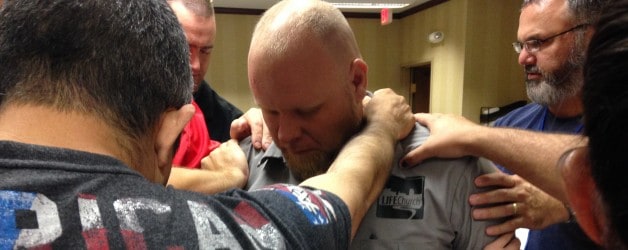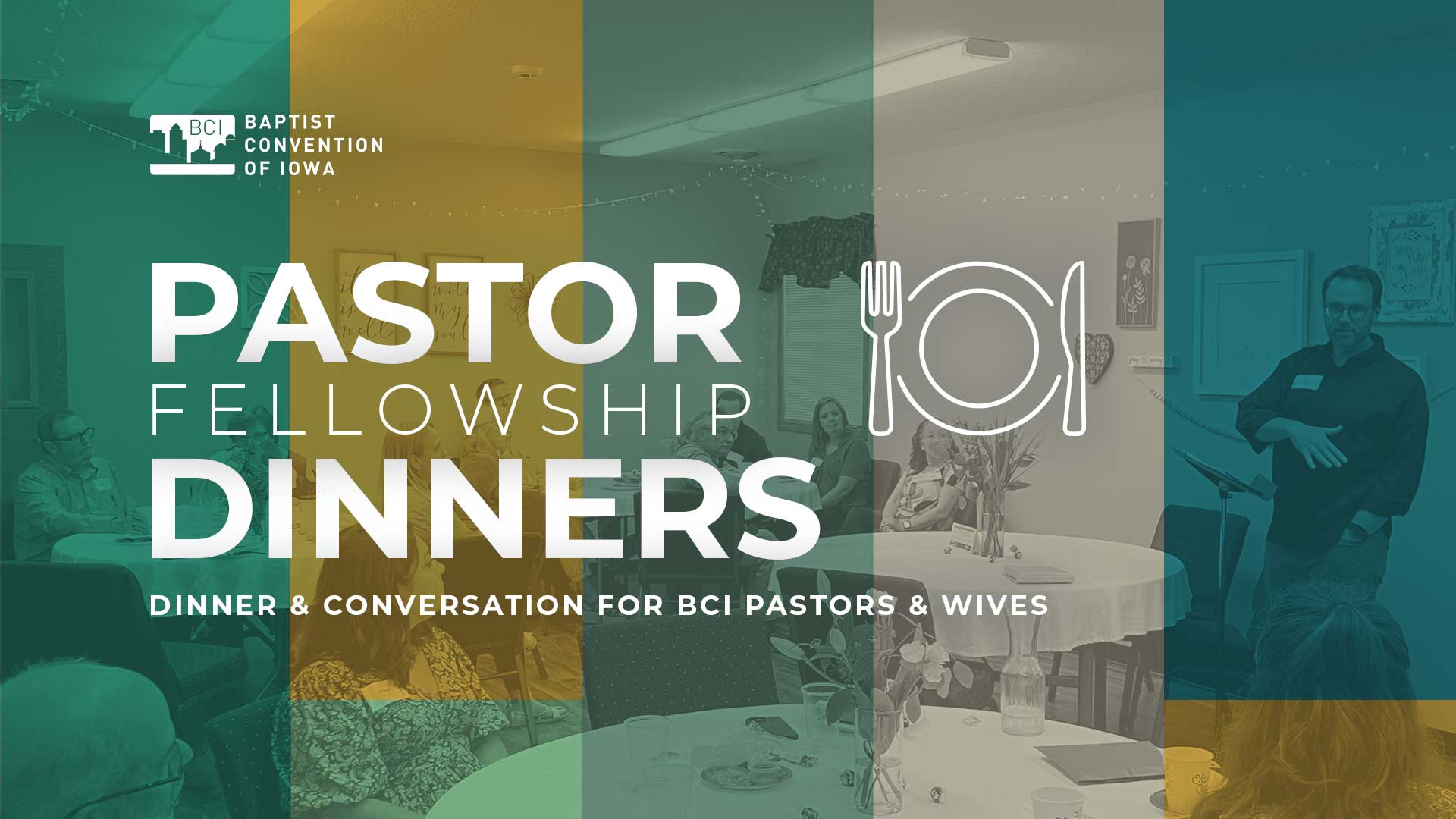
By Lee Warren
SIOUX CITY, Iowa (Minnesota-Wisconsin Baptist & The Pathway) — Participants of the Heartland Interstate Strategy (HIS) vision tour exited the bus on Prospect Hill and gazed into South Dakota, Iowa and Nebraska. Dr. Leo Endel, a former pastor in the area and the current executive director of the Minnesota-Wisconsin Baptist Convention provided a brief history of the region and then led them in prayer.
“Lord, You called us to a purpose -– to go and make disciples of all nations,” Endel said. “And there are vast groups of people west of us, just like 150 years ago, that do not know Your Son as their Savior and You have brought us to this place today, not by accident, but by calling.”
He was referring to three Presbyterian missionaries -– Sheldon Jackson, T.H. Cleland and J.C. Elliott — who, in 1869, looked across that same great expanse on that same hill and prayed for “the great unchurched areas,” as the monument on that hill that has been erected in their honor says.
The evangelical presence in the area has waned in recent decades, but HIS stood on the shoulders of these three missionaries from the 1800s, asking the Father to renew a passion among his people to bring the Gospel to a largely unreached people group right here in our own country.
That’s what this vision tour was all about -– making people aware of the vast need, and then presenting ways SBC churches in the south can partner with churches in the north.
The tour –- that included 40 plus people from Kentucky, Missouri, Iowa, South Dakota, Minnesota and Nebraska -– started in Omaha, Nebraska on August 26 and made stops in Sioux Falls, South Dakota and Sioux City, Iowa, before returning to Omaha on August 28.
Representatives from the five state conventions and one Canadian province that comprise HIS –- the task force that is focused on facilitating church plants up and down the I-29 corridor that stretches from Kansas City to Winnipeg, gave presentations about the work that is already being done in each respective area, while also presenting the great spiritual needs that are so prevalent along the corridor.
In Omaha, participants gathered at the Eastern Nebraska Baptist Association building and heard from a number of Omaha SBC pastors, including Lee Cordell from Redeemer Church, Dr. Steve Holdaway from LifeSpring Church and Craig Liscom from Changed Life Church. They also heard from Pastor Ricky Rohrig from Crossroads Community Church in Red Oak, Iowa, Rick Posey who plans to plant a church in Blair, Nebraska and representatives from St. Joseph, Missouri and the Flint Hills Baptist Association (churches in north central and northeast Kansas) – all of whom are facing challenges in one form or another, from reaching into multi-cultural neighborhoods, to spiritual darkness, to a culture that has little or no biblical understanding.
Endel closed the event in Omaha by presenting a history of the SBC and its positive evangelical influence in the upper Midwest in previous decades. He contrasted that with the current lack thereof, pointing toward a map that shows limited Southern Baptist witness north of Missouri.
“When you get up into northern Iowa, and then up into most of Minnesota, Wisconsin and the Dakotas, up the I-29 corridor, you’ll see no presence at all,” Endel told the group. “That means we have no churches in those areas, at all.
“At one point, there were approximately 402 counties in the entire United States without a Southern Baptist presence, at all, and I had 102 of them in Minnesota and Wisconsin. And if you look at the rest of the map, you’ll notice that the Dakotas and Nebraska are equal to the challenge.”
Given the lack of evangelical witness in the area, Endel pointed out the problem many unbelievers along the corridor face when they do attend a church.
“When you come to Minnesota and Wisconsin, the likelihood of you going to a church where you are going to hear the Gospel articulated in a way that you can understand it and respond is pretty remote,” he said.
Endel asked the attendees a question that has been on his mind for some time.
“What if we could take Missouri strength, and our southern partners from elsewhere, and press up north, and then east and west to reenter into all of these areas?” he said. “What could possibly happen? The needs are tremendous.”
The vision tour continued up I-29 to Sioux Falls, where it heard from Jonathan Land, who recently planted Connection Church in a public school in the area. He used nine block parties this summer to make contact with 2,200 people who registered for the events and he is seeing a slow but steady increase in attendance at his church. They have had as high as fifty attendees, but much work is left to be done.
Jon Merchant runs Next Door Ministries in Sioux Falls and he explained how his organization goes into mobile home parks to help renovate them while building relationships so they can share the G
ospel. Since many are skeptical about church, he said they won’t walk into one, so he’s taking the church to them – setting up a network of home churches right there in the mobile home community.
“Bible … they don’t know what that is,” Merchant said. “Church … they don’t know what that is. But they ask a lot of questions about God and spiritual things, so the door is open there.”
Pastor Brent McNeal spoke about starting a Bible study in 2012 in Moorhead, Minnesota, and how that eventually led to Sojourn Church – the only SBC church in the city. They have since baptized two people, one of whom shared the Gospel with two high school friends who placed their faith in Christ.
Pastor Tim Brown from Life Church in Fargo, N.D., spoke about the importance of his congregation embracing missionary status at work, school and play. The church is a year old. Brown says they are reaching the dechurched, the detached and the hurting, saying that’s a good description of the twenty-five people who already attend.
Pastor Rod Giesbrecht of Tabor Baptist Church in Winnipeg has about 20 attendees on a good Sunday, half of whom are elderly. The other half are international students with varying religious backgrounds. But even a small church like Tabor is making a difference.
They are working with a church planter who is reaching out to the 12,000 Punjabi Sikhs in the area. Sikhism is a monotheistic religion, with a blend of Buddhism and the Muslim faith. After offering eye clinics for the Sikh population as well as reaching out to them through an ESL program, they are beginning to be open to hearing about Jesus.
In Sioux City, the vision tour stopped at Southern Hills Baptist Church where attendees heard about plans to implement a program called Life Changers, a twist on Word Changers, that will be spearheaded in Sioux City next June with the hope of serving and engaging the community for Christ. And they learned about a new plant in town called Redemption Hill Church that is just about to launch.
The spiritual needs in the upper Midwest are great, but the underlying message of the tour was clear – we serve an even greater God, who can and does meet needs through his church. HIS wants to make those needs known so prospective partnering churches can get involved with prayer support, short-term mission teams and financial support. And, of course, they are praying for more plants along the corridor.
HIS coordinator Jeffrey Chavez summarized the historic cooperative effort this way.
“These pastors and church planters are similar to soldiers who are out there on the battle field,” Chavez told The Pathway. “They are fighting these battles at the forefront and we are going to be their support group.”
For more information about the
Heartland Interstate Strategy
go to: mobaptist.org/partnership-missions/his
This article originally appeared in The Pathway (mbcpathway.com), newsjournal of the Missouri Baptist Convention. Lee Warren is a contributing writer for The Pathway.







